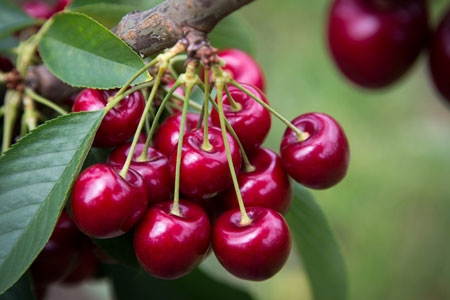In a recent video*, Tasmanian Institute of Agriculture (TIA) researchers Dr Nigel Swarts and Dr Peter Quin talk about new research findings that may change the way we manage nitrogen fertiliser in cherry orchards.
They answer the big questions:
• When is the best time to apply nitrogen, based on tree uptake
• How much nitrogen does a cherry tree need to produce premium quality fruit
• Are alternative nitrogen forms as effective as traditional fertilisers.
The project is funded by the Australian Dept of Agriculture, Water & Environment through the More Profit from Nitrogen program, with co-funding from Hort Innovation. Industry partners are Cherry Growers Australia, Reid Fruits (Andrew Hall), and Wandin Valley Orchards (James Clements)
Key points from 2020 project update
• Conventional and biological fertilisers perform well under field conditions
• Time to establish change in fertiliser regimes needs to be taken into account
• Substantially less N than current grower use is required to achieve adequate fruit quality.
A summary of the project (from their fact sheet*) is presented below
Project aims
The research project, Optimising the efficient use of nitrogen in cherry orchards aims to maximise nitrogen use efficiency in the Australian cherry industry to increase productivity, profitability and improve environmental management.
Nitrogen uptake and storage
Nitrogen (N) is an essential nutrient for cherry tree development and fruit production, but the timing of a tree’s demand for N is not clear. Nor is it known how much N a tree stores during dormancy for use in the following season.
To help answer these questions a three year trial has been established at Wandin Valley Orchards, Rosegarland, using 6-year old Lapins on Colt rootstock.
Nitrogen sources
Cherry trees can access nitrogen from three sources: Soil Nitrogen, including the soil solution; Stored Nitrogen, in roots, trunk, branches, buds, leaves and fruit; and Supplementary Nitrogen, applied to the tree as fertiliser.
By supplementing the tree with labelled 15N calcium nitrate, we can answer many questions about how N is used, distributed, stored or lost to the environment over time and which source of N is most important at any given time.
The first series of trials traces the fate of labelled N applied at various times throughout the growing season and how this relates to uptake and storage.
Nitrogen (N) timing 2017–2018
The four treatments received a total of 90 kg N/ha split into four equal applications over the season, applied at different times (Fig 1).
Labelled 15N calcium nitrate was applied by drip fertigation to the treated cherry trees. The first application was on 8 November 2017.
We analysed the total N and 15N content of leaf samples taken throughout the season followed by fruit at harvest and falling leaves captured with nets after harvest. Fruit yield and quality was also assessed at the normal harvest time.
Digging up trees in the name of science
We will excavate whole trees in winter 2018 and again just before harvest in late 2018. This will establish how much stored N has been remobilised and how much the tree has drawn from soil resources.
This will help pinpoint critical times for nitrogen application and the formulation of efficient N-application strategies for growers.
Does nitrogen timing affect fruit quality?
At this early stage, no significant differences were found in fruit quality that related to the timing of N application.
15N analysis will reveal if previously existing soil N or N stored in the trees from the previous season is masking this effect.
Rainfall and nitrogen loss
After heavy rainfall in December 2017 we measured significant losses of nitrogen as emissions to the atmosphere as the potent greenhouse gas nitrous oxide (N2O).
Over an 8-day period the emissions spiked with an equivalent of 334 g/ha/day of N2O-N emitted from above the drippers of trees fertigated a week earlier.
This rate of emission was more than 12 times greater than a similar period experiencing average rainfall. This emphasises the importance of trying to avoid N-fertilisation when heavy rain is imminent, especially as leaching of nitrate-N is known to remove large quantities of N to below the root zone.
Rates and sources of nitrogen application
An additional three year trial has been established at Reid Fruits’ Honeywood Orchard at Jericho, to examine the effect of different rates of calcium nitrate application on tree development.
It will also compare a standard rate of this fertiliser with an equivalent quantity of N applied from organic sources.
Another treatment includes a microbial soil inoculant, to test its influence on N uptake.
*The video is available at: www.youtube.com/watch?v=jQyR8hKcSXg
*The fact sheet and more information about the project can be found here:
www.utas.edu.au/tia/research/research-projects/projects/nitrogen-use-in-cherry-orchards
See this article in Tree Fruit June 2020






















